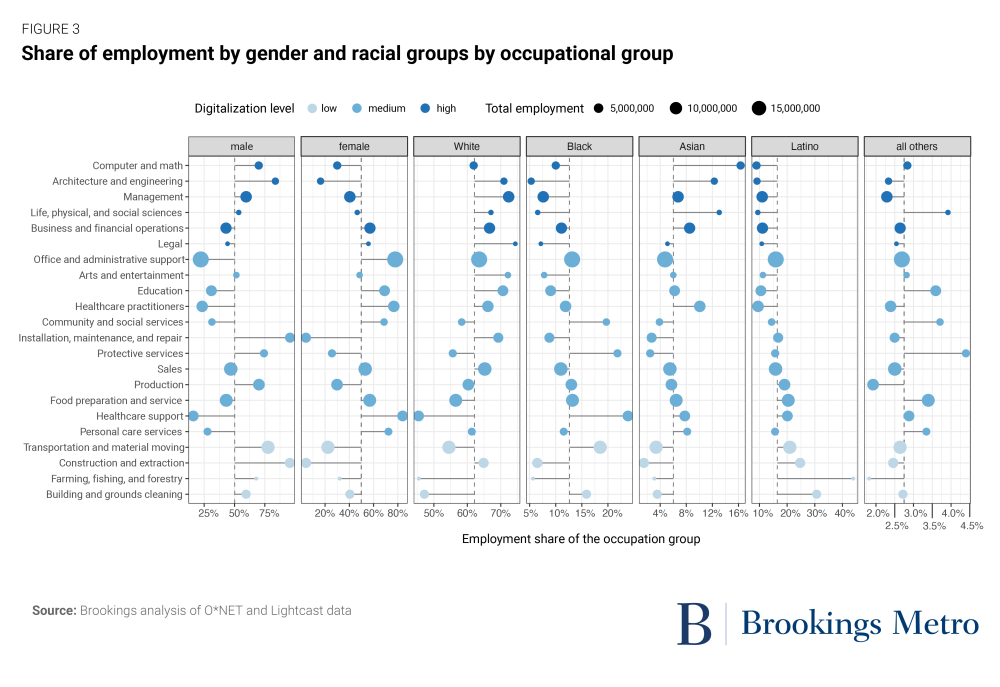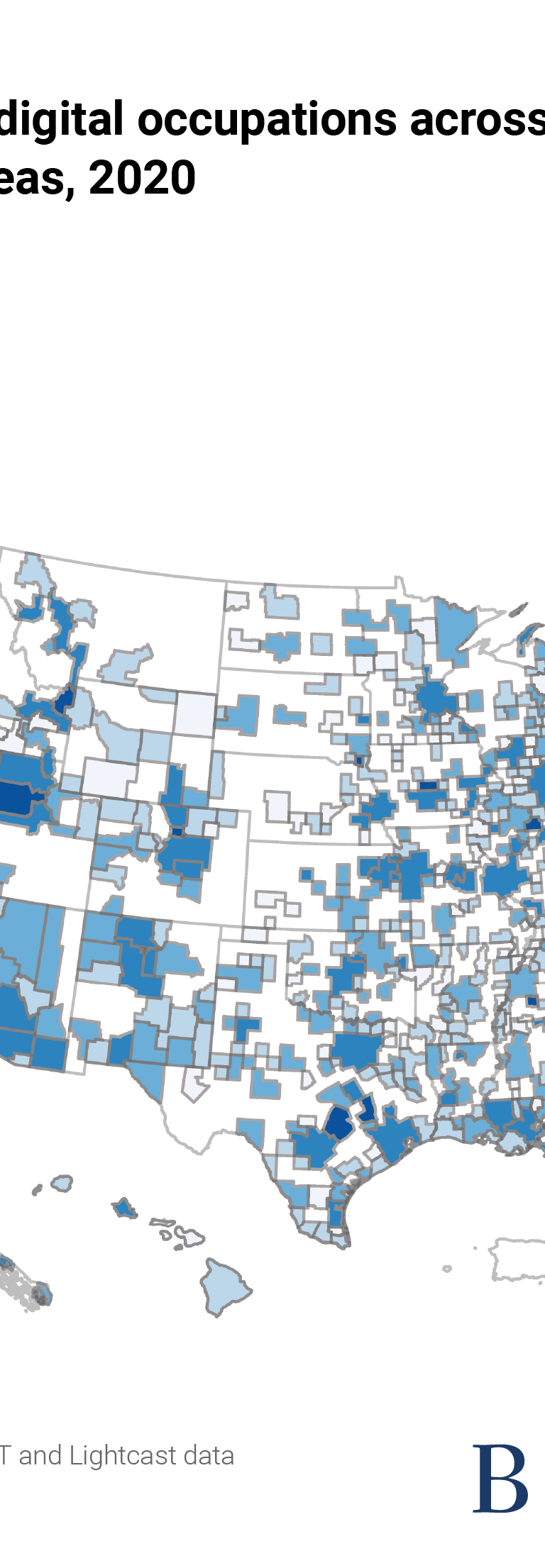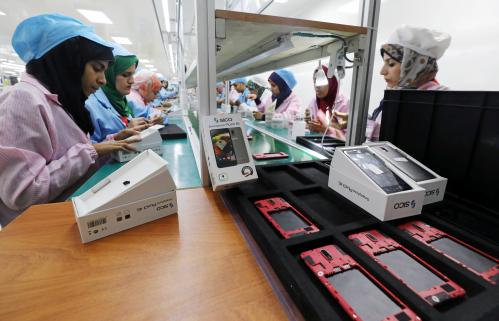One of the most striking developments of the last decade has been the rapid “digitalization” of work—and with it, an urgent demand for skill-building.
Digitalization is the infusion of digital skills (though not necessarily higher-end software coding) into the texture of almost every job in the economy. And it has inordinate power to both empower workers or divide them. That’s because gaps in access to digital skills engender disparate access to the nation’s best-paying, most desirable jobs and industries. Such gaps can spawn troublesome divides among not just people, but also places. Indeed, what is particularly concerning is the extent to which these divides have been playing out across the nation’s uneven geography of cities, towns, and rural communities. In fact, digitalization divides across and within places now stand as one of the nation’s starkest limits on opportunity.
However, recent shifts in post-pandemic labor market demands coupled with a surge of new federal and state policy experiments are building the potential for a distinctive new policy paradigm—one that addresses the nation’s digitalization divide and the desperate need for skill-building and digital transformation in communities.
Specifically, a new set of sizable “place-based” investment policies—focused on boosting innovation, tech clusters, and workforce training—suggests a potential playbook for responding more effectively to the need for not just digital inclusion, but also improved local opportunity more broadly.
This report discusses this potential and how experiments in place-based problem-solving are accelerating digital skill-building and local economic development. In doing so, we outline the ways communities, states, philanthropies, corporations, and other organizations can leverage place-based approaches for addressing digital transformation and related economic development challenges.
Digitalization empowers, digitalization divides: An update on recent trends
In reviewing recent digitalization trends, two key facts emerge. First, the digitalization of work is expanding. And second, so are the benefits and divides it can bring.
The digitalization of work continues to expand
To the first point, the digitalization trend—as measured by the digital content of 761 occupations, covering 98% of the U.S. workforce—diffused into more and more jobs in the last decade, well beyond the levels reported in a 2017 Brookings report.1 Looking across all jobs, the overall digitalization score of U.S. work jumped from 32 in 2002 to 44 in 2010, and continued to rise to 48 in 2020 (see text box below for an explanation on digitalization scores).
Defining and measuring digitalization
The “digitalization score” of a job reflects the level and importance of digital content for that occupation. Brookings derives the measure from the O*NET survey, a unique occupational survey database from the Department of Labor that provides detailed, survey-based information on the skills, knowledge, tools, and work context of each occupation. The measures are standardized to range from 1 to 100, with higher digitalization scores representing higher digital content in that occupation. A score of 60 or above marks an occupation as having a “high” digitalization level, and a score above 33 but below 60 is deemed “medium.” For a detailed methodology on how we constructed digitalization scores for jobs, industries, groups, and places, please refer to our 2017 report, “Digitalization and the American workforce.”
The ongoing shift is most pronounced in the growth of occupations defined as having a “high” digitalization level. These jobs require relatively robust knowledge of computers and electronics, meaning that digital tools and skills are of great importance for the occupation (e.g., software development or engineering).
From 2002 to 2010, the share of occupations with a high digitalization level doubled, from 9% to 18%. In 2020, this rose further, to 26%. That means more than one-quarter of jobs now require substantial digital skills. What’s more, over three-quarters of jobs now have either a high or medium level of digitalization. Conversely, the share of jobs with only a low digitalization level has dwindled from 29% in 2010 to 23% in 2020.
The digitalization of work continues to drive pay gains
As the digitalization of work expands, so do its benefits. Digital technologies raise many workers’ productivity, so they often raise the wages of those who have them. For example, the average earnings for jobs with a high digitalization level reached about $79,000 in 2020, compared to $54,000 for jobs with a medium level of digitalization and $35,000 for jobs with a low level. In keeping with that, the wage premium for jobs with a high digitalization level as opposed to a medium level has crept up to 47%, from 41% earlier in the decade.2
At the same time, digitalization facilitated the rapid switch to remote work during the COVID-19 pandemic, which has in turn enhanced many workers’ lives. In 2020, 74% of high-digitalization-level jobs could be performed entirely from home, compared to 27% of jobs with a medium digitalization level and 0.3% of jobs with a low level.3 With remote work likely to stay at elevated levels, it is important that digital skills enable it for workers and managers.
Sharp gender and racial disparities persist
Yet the fact remains that digitalization and its benefits remain unevenly distributed across people and places. And given the differing skill levels of diverse groups of people, digitalization is reinforcing long-standing demographic and geographic opportunity gaps.
Men remain overrepresented in high-digitalization-level occupations such as engineering, as well as in low-digitalization-level occupations such as construction. Women, on the other hand, represent around three-quarters of the workforce in medium-digitalization-level occupations, such as office administration, education, health care, and social services.
The same disparities exist in the employment profiles of racial and ethnic groups. Except for Asian Americans, people of color remain significantly underrepresented in most if not all high-digitalization-level occupations.
Geographic digitalization divides remain
In addition to gender and racial disparities are the wide variations in digital skill levels across places, which bring with them wide variations in economic well-being.
On this front, the higher a community’s aggregate digitalization score, the higher its pay levels. Accordingly, the places with the highest shares of high-digitalization-level jobs in 2020—such as Boulder, Colo.; San Jose, Calif., and Washington, D.C.—are also the ones with the highest mean annual wages, in the range of $70,000 to $100,000. By contrast, places with low digital scores—such as Elkhart-Goshen, Ind. and Twin Falls, Idaho—deliver much lower annual wages for their residents, along the lines of $50,000.
Given this divergence, significant divides in skill and pay levels persist not just between groups of people, but between whole communities and regions of the country. For example, across the nation’s 56 largest metro areas, as many as 30% of all jobs had a high digitalization level as of 2020, while low-digitalization-level jobs comprised just 22%. By contrast, in the nation’s 500-plus “micropolitan” areas, high-digitalization-level jobs account for only 20% of all occupations, and low-digitalization-level jobs account for 26%. And pay gaps reflect those divides.
Similar divides separate coastal “superstar” metro areas and heartland cities. In cities such as New York and Seattle, the share of jobs with a high digitalization level ranges from 27% to 35%, whereas it reaches just 15% to 19% in heartland centers such as Odessa, Texas, Meridian, Miss., and Appleton, Wis.
Significant variations exist among small regions too. Small towns such as Los Alamos, N.M., Ann Arbor, Mich., and Huntsville, Ala.—which are home to national labs, universities, or military bases—are among the regions with the top 10 digitalization scores in the U.S. On the other hand, resources-oriented small metro areas and micropolitan towns such as Morristown, Tenn., Brownsville, Texas, and Williston, N.D. rank at the bottom of the digitalization scale.
In sum, the uneven quality of the local systems preparing people and places for the digital economy makes expanding digital adoption among disconnected groups and communities an essential priority. With so many people and places still left behind, connecting them will require more urgent and directed work than has yet been attempted.
Green Bay, Wisc.
Place-based responses may be able to narrow digitalization divides
The widening gulfs in digitalization and associated skill-building has prompted newfound interest in place-based problem-solving for addressing these big challenges. Broad national or statewide programs have their value, but they often lack the focus to confront entrenched problems. Place-based strategies also pursue universal goals, but do it by concentrating on the particular needs of particular places.
In this regard, place-based strategies can engage more closely with the sources of problems and the needs of individuals and groups in local communities. At their best, they leverage the “bottom-up” energy and networks of localism to unleash and organize places’ instincts toward self-empowerment.
These more granular approaches are having a moment, as more actors recognize that a variety of institutions (states, federal agencies, global corporations, philanthropies) can design and implement place-based programs across a variety of scales and sites to address a variety of challenges.
The initiatives vary widely. Philanthropies have led in experimenting with place-based problem-solving, as in the case of the Ewing Marion Kauffman Foundation’s engagement with the National League of Cities’ City Inclusive Entrepreneurship Network. Now in its third year, the network has made awards in over 200 cities to support tangible initiatives to drive inclusive development, including in the “civic tech” domain. The program provides member cities with direct technical assistance via one-on-one quarterly coaching calls as well as opportunities to share best practices and review progress.
Likewise, major corporations have developed their own place-based philanthropic initiatives. Since 2018, JPMorgan Chase’s Annual Challenge (previously called the AdvancingCities Challenge) has structured a series of annual competitions to source “innovative and sustainable solutions to address the most persistent problems facing communities.” The place-based challenge grant program has awarded over $80 million to 19 collaboratives engaged in projects pursuing equitable growth—some with a focus on helping women and vulnerable populations access technology and technology-adjacent careers. The challenge is part of a $500 million, five-year initiative to drive inclusive, equitable growth and create economic opportunity in communities.
For its part, Microsoft is expanding its five-year-old TechSpark program—a place-based civic program focused on local digital transformation and economic development in seven small or midsized communities and three larger metro areas across the U.S. TechSpark has sought to address the persistent digital divide facing communities of all sizes. To that end, the program has leveraged Microsoft’s many assets and programs to support inclusive digital advancement. These efforts include providing a full-time, place-based Microsoft point person; digital access initiatives; digital skills training; and entrepreneur support. The company is currently looking to build on its learnings and initial success to test whether it can diffuse TechSpark across the country more widely by utilizing its existing field team to take on new states, develop a playbook of resources, and partner with new regions and their leading nonprofits. (Disclosure: Microsoft is a funder of this research.)
There is also an increasing number of government place-based experiments. The state of Indiana, for example, has invested $500 million to call forth and support “bottom-up” regional development plans aimed at catalyzing advanced-economy growth and talent development in 17 local areas, many of which are struggling. Gov. Eric Holcomb is now seeking an additional $500 million to fund another round of the popular program.
At the same time, and most significantly, the federal government has launched a series of landmark place-based challenge grants to take on tough issues in regional skill-building and tech-oriented economic revitalization. Most notably, the Economic Development Administration (EDA) has announced major allocations of its $3 billion allotment of American Rescue Plan funding to stand up a $500 million Good Jobs Challenge (GJC) on workforce development and a $1 billion Build Back Better Regional Challenge (BBBRC) on high-value economic development.
Like the other efforts, these sizable federal programs are noteworthy in that instead of diffusing resources across all of America through universal block grants available to all places, they target particular places and seek the best ideas by using a national competition to call forth the best proposals from among scores of local consortia. On the digitalization front, 11 of the 32 Good Jobs Challenge grants went to a diverse set of industry-led, IT-related worker training partnerships in places ranging from Connecticut and Miami to Minnesota and North Dakota. Similarly, compelling ideas for technology acceleration and economic growth pervade the 21 strategies that won $25 million to $65 million from the BBBRC, and which seek to boost inclusive tech clusters in places such as Pittsburgh, Fresno, Calif., and across the Great Plains.
Fargo, N.D.
Two other federal programs—still to fully roll out—also are adopting place-based strategies. Underway now, a bold Regional Innovation Engines competition from the National Science Foundation (NSF) is seeking to identify five regional consortia with compelling strategies for catalyzing tech-based innovation ecosystems in struggling areas. Funds have also been appropriated to launch a Department of Commerce competition to create large-scale “regional technology and innovation hubs” in 20 communities across the country. The latter—along with its companion RECOMPETE Pilot Program—could represent the largest single place-based federal investment in several generations if fully funded in future years.
Overall, the thought in all of these efforts is that external engagement and investment—in support of the best ideas by committed local consortia—have the power to catalyze and accelerate “bottom-up” local problem-solving. In the case of the nation’s digital geography, such place-based policies have emerged as a natural tool to address tech gaps by targeting left-behind places.
In any event, the trend is clear: As the nation’s digital and economic divides persist, place-based initiatives are becoming more important in bridging them.
Recommendations for a place-based digitalization playbook
Looking through the new place-based programs, it’s currently impossible to know which ones will best deliver digital access, digital skills training, tech growth, and other gains. Analysis of that will take time, including through work Brookings Metro is undertaking in partnership with the EDA to document and assess the initial implementation of the BBBRC over the next 18 months.
With that said, the following section presents a short list of initial design principles that can be discerned from the new place-based initiatives, which may be useful to those designing and executing further place-based programs.
Focus on geography
Place-based initiatives are, by definition, place-focused—they seek to benefit people and economies by targeting specific geographies of concern. In that way the policies likely represent an especially efficient and effective way to intervene in some problems, such as the digitalization gap. And yet, the “places” targeted can vary. Designated geographies for recent place-based programs span from big-city neighborhoods to sprawling rural counties, such as for TechSpark Washington. And through one Good Jobs Challenge grant, the digital apprenticeship institute Apprenti will manage tech training and hiring across 11 states. With that said, projects at the metropolitan area scale make the most sense for many projects, given the similar scale of many regional industry clusters, labor markets, and leadership networks. Such rootedness can engage with the “micro” origins of problems and solutions.
Go bigger to make a difference
Many past place-based programs have been ineffective because they were too small. The emerging new generation of programs is seeking impact by going bigger—and multiplying their efforts across numerous communities. For example, recognizing the scale of systems and flows within a digital economy, the BBBRC is providing five-year grants ranging from $25 million to $65 million to 21 regions—significantly more places and larger dollar amounts than the historical norm at the EDA. Beyond that, the NSF Regional Innovation Engines program plans to award up to $160 million each to five regional consortia over 10 years, and its regional tech hubs program will award $10 billion to create 20 centers if fully funded. And for its part, JPMorgan Chase has invested as much as $200 million in designated “signature” cities such as Detroit. In short, those who want to ameliorate the nation’s digital and economic imbalances are realizing they need to invest robustly at scale.
Rise to the challenge
On their own, neither broad “top-down” programs nor targeted “bottom-up” initiatives will amass enough leverage to reduce major regional divides. That’s why the emerging model for place-based policymaking often combines high-level direction-setting and resources with bottom-up passion, knowledge, and execution. On the one hand, all of the initiatives discussed here set out a desired “macro” direction for action, mostly focused on national economic resurgence via cluster-based technology growth, digital skills, and racial and geographical inclusion. At the same time, the initiatives leverage prize competitions to call up the most compelling local strategies. In that way, the new programs invest in large-scale national priorities in a top-down manner, but do so in a way designed to unleash regional creativity, local networks, and energy. Such “jump-ball” designs, as a recent Brookings assessment of the BBBRC observed, have special power to “catalyze local urgency and financing” while “rooting out ‘business-as-usual’ approaches” and “motivating new community networks to rally around a shared agenda.”
Local networks and trusted local point people matter
Dynamic place-based business, academic, civic, and neighborhood networks are essential to delivering strong place-based gains. For that reason, the current surge of place-based tech and skills initiatives focuses on rigorous program design and implementation, but thinks as much about governance, networks, local buy-in, and trust—the “soft” virtues. Microsoft, for example, employs a full-time, locally residing “engagement manager” in each TechSpark region to spearhead the interplay between the company’s support and regional priorities and networks. The Good Jobs Challenge directs awards to either the “system lead entity” of a regional workforce system or the “backbone organization” of a sectoral partnership. And the BBBRC requires the designation of a strong regional coalition to implement local projects, with an economic competitiveness officer and formal lead institution to coordinate initiatives. More pointedly, the NSF Regional Innovation Engines funding announcement contains extensive discussion of the desirable “ecosystem partners and stakeholders,” “Engine Culture,” “Culture of Innovation,” “Culture of Diversity, inclusion, and Accessibility,” and “Engine Leadership and Organization Structure.” In short, place-based problem-solving requires special attention to place-based networks and leaders.
Stress capacity-building and learning
Related to the importance of dynamic local leadership networks is the attention paid to capacity-building. To improve the chances that place-based strategies will improve the fortunes of struggling places, many of the new programs make available extensive preparation grants, technical assistance, and learning forums. The Good Jobs Challenge, BBBRC, and NSF Regional Innovation Engines program are all investing in extensive consultations, forums for information-sharing, and the creation of formal “communities of practice” to support learning, collaboration, and expert assistance. The latter two make available smaller, stage-one development awards to help awardees organize and prepare their plans in advance of competing for full-scale, multi-year stage two awards. In this way, the new place-based initiatives seek to help new and different places build capacity and learn from one another.
Evaluate rigorously
Finally, several emerging place-based initiatives have put in place reporting and assessment mechanisms that point in the direction of the true evaluation needed to learn from the projects and determine what works. In the case of the BBBRC, the EDA has committed to working with awardees to monitor outcomes across its portfolio. Last summer, the agency awarded $1.3 million to Purdue University’s Center for Regional Development and Brookings Metro to lead research and evaluation efforts on the BBBRC portfolio so that grantees and the EDA can measure success and amplify success stories. For its part, the NSF Regional Innovation Engines program proposes a rigorous set of assessments of competition winners, requiring each to develop a comprehensive evaluation plan that establishes appropriate criteria, goals, indicators for success, and growth indicators. In addition, the NSF plans to conduct annual reviews of each winner’s performance to inform future funding. The Upjohn Institute’s Timothy Bartik, Brian Asquith, and Kathleen Bolter are right that it is imperative that new programs be evaluated rigorously so we learn if they are working well and how to improve them. Such checks and evaluations will allow a burst of learning and insights to hone further investment in what works to support more digital connections.
Conclusion
The challenge of digitalization gaps and disparities has grown, but so has optimism about the rise of a new era of place-based tools for responding to them. With these tools comes the promise of going deeper, getting more specific, and enlisting local people more directly in solutions.
To be sure, this is hard work—and hard to scale. However, the new initiatives point the way forward. Those who think everyone can and should benefit from the digital economy though access to its tools and resources are right to welcome the new experiments in place-based responses to digitalization divides.
Interactive data: view digitalization scores by geographic area or occupation
Acknowledgements
The Brookings Institution is a nonprofit organization devoted to independent research and policy solutions. Its mission is to conduct high-quality, independent research and, based on that research, to provide innovative, practical recommendations for policymakers and the public. As such, the conclusions and recommendations of any Brookings publication are solely those of its authors, and do not reflect the views of the Institution, its management, or its other scholars.
Brookings is committed to quality, independence, and impact in all of its work.
Funding for this report was provided by Microsoft with additional support from the Kresge, Joyce, Kauffman, and McKnight foundations and the Economic Development Administration (EDA).
Brookings Metro is also grateful to the Metropolitan Council, a network of business, civic, and philanthropic leaders that provides financial and intellectual support for the program.
In addition, the authors thank Scott Andes and Alex Jones at the EDA for their insights into the Build Back Better Regional Challenge; Daniel Goetzel at the National Science Foundation for background on the Regional Innovation Engines program; and Jon Cardinal in the office of Sen. Chuck Schumer for discussion of the Regional Technology and Innovation Hubs program.
For their astute comments and advice on drafts of this paper, the authors wish to thank their colleagues Alan Berube, Annelies Goger, Robert Maxim, and Joseph Parilla. Yang You provided help with the manuscript and graphics.
In addition, the authors wish to thank Leigh Balon, Michael Gaynor, David Lanham, Carie Muscatello, Erin Raftery, and Peter Rezk for their editorial, design, and communications expertise.
Photo credit: Green Bay Packers, Microsoft
About Brookings Metro
Brookings Metro collaborates with local leaders to transform original research insights into policy and practical solutions that scale nationally, serving more communities. Our affirmative vision is one in which every community in our nation can be prosperous, just, and resilient, no matter its starting point. To learn more, visit brookings-edu-2023.go-vip.net/metro.
-
Footnotes
- O*NET data had multiple updates since our 2017 report, which allowed us to expand the original 545 occupations to 761 occupations. The digitalization scores and shares reported in this update may not be exactly consistent with our last report.
- This wage premium still holds even after controlling for education requirements, except at the doctoral level, where medium-digitalization-level occupations such as surgeons and physicians typically dominate the pay scale.
- Authors’ analysis based on classification created by Jonathan Dingel and Brent Neiman. “How many jobs can be done at home?.” Journal of Public Economics 189 (2020): 104235.














